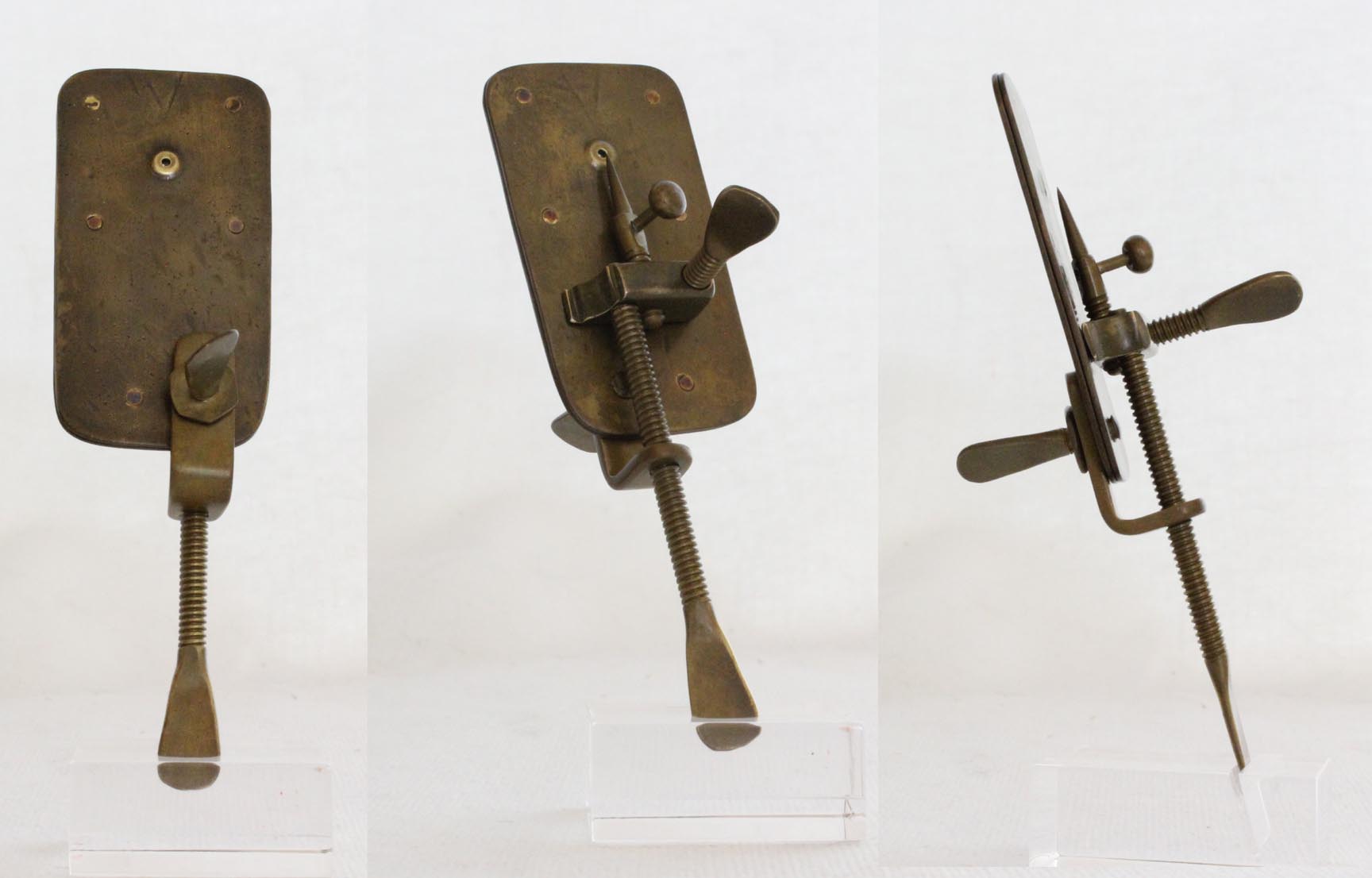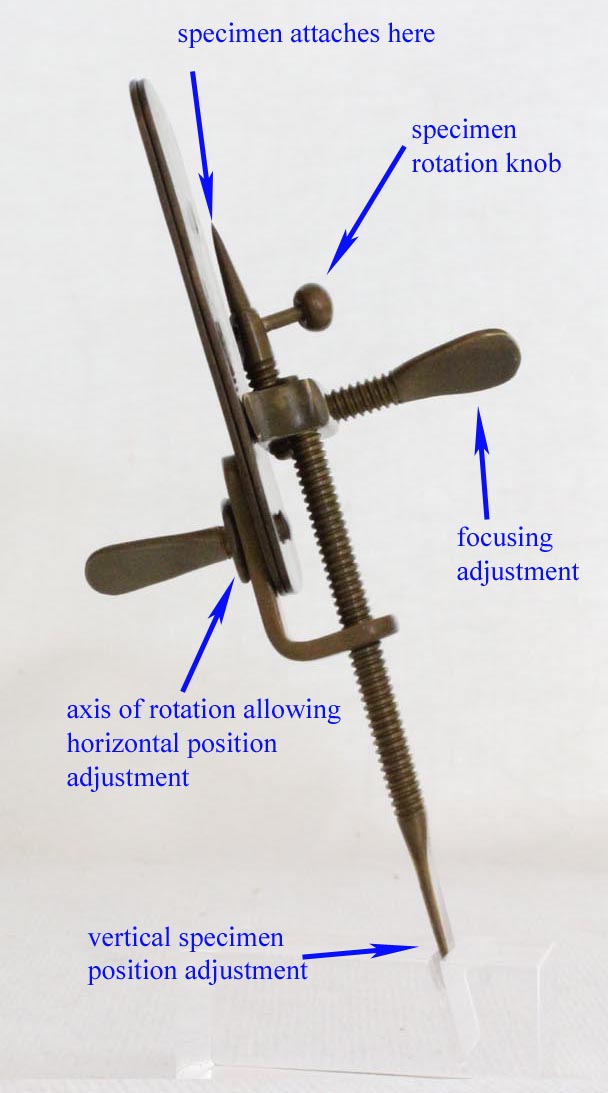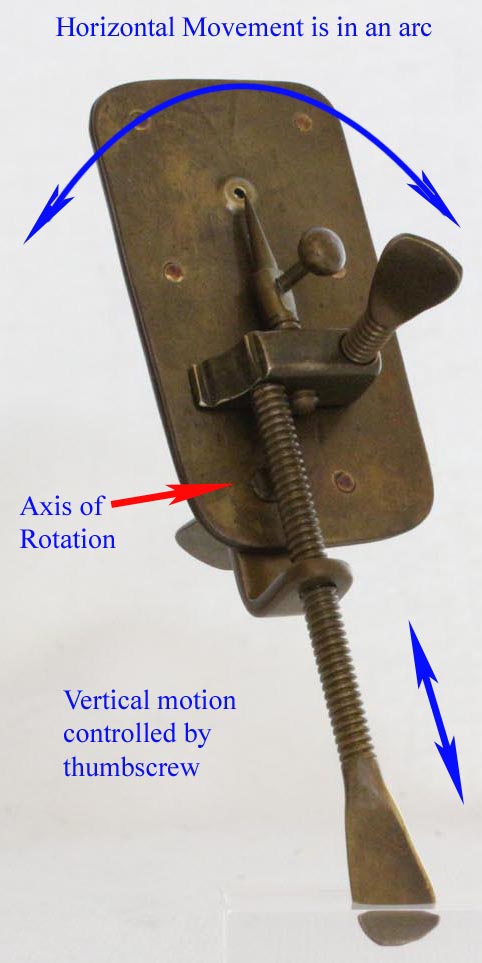MICROSCOPE-ANTIQUES.COM © 2013-15.
The Microscope of Antoni Van Leeuwenhoek (replica of silver microscope at the Boerhaave Museum in Leiden)
In Use: circa 1668-1723


 Antoni Van Leeuwenhoek, the greatest microscopist of his time,
is known to have constructed microscopes very similar to that shown here. This replica was made in 2015 and sold by Christopher Allen Replicas, UK. It is very similar to a silver example in the Boerhaave Museum in Leiden. Unlike that one, it is made
of brass, like many of van Leeuwenhoek's microscopes, though he did make many of them out of silver and a very few of gold. This microscope measures only about 3 3/8 inches (82mm) long in greatest dimension (edge of longest thumbscrew to far edge of main plate). The rectangular plates measure only about 1 inch (25 mm) by 1 7/8 inches (51.5 mm). It consists of two thin brass plates, between which is sandwiched a small, spherical round high-power lens. The lens is held in place by dimples on each plate. The plates are held together by 5 rivets and the screw supporting the L-shaped support. The rest of the microscope consists of a simple attachment to hold the specimen. The long thrumbscrew, which is threaded through the L-shaped support, controls vertical motion of the specimen held on the pointed spike. The L-shaped support is held in place by a thumbscrew which passes though both plates. The horizontal movement of the spike is in an arc with its axis through th. Finally the spike can rotate via a tiny knob. The specimen can therefore be partially rotated. The finish on this microscope, like the surviving examples by Van Leeuwenhoek himself, has an oxidized brass patina. In use the microscope must be held very close to the eye. Since it is held in the hand, one must be able to hold it steady and have reasonably good eyesight to be able to use it to full advantage. Although Van Leeuwenhoek's microscopes ranged from about 40 to over 250 power, this one is about 100 power. There is some indirect evidence that he made some microscopes of over 400 power, though none are extant.
Antoni Van Leeuwenhoek, the greatest microscopist of his time,
is known to have constructed microscopes very similar to that shown here. This replica was made in 2015 and sold by Christopher Allen Replicas, UK. It is very similar to a silver example in the Boerhaave Museum in Leiden. Unlike that one, it is made
of brass, like many of van Leeuwenhoek's microscopes, though he did make many of them out of silver and a very few of gold. This microscope measures only about 3 3/8 inches (82mm) long in greatest dimension (edge of longest thumbscrew to far edge of main plate). The rectangular plates measure only about 1 inch (25 mm) by 1 7/8 inches (51.5 mm). It consists of two thin brass plates, between which is sandwiched a small, spherical round high-power lens. The lens is held in place by dimples on each plate. The plates are held together by 5 rivets and the screw supporting the L-shaped support. The rest of the microscope consists of a simple attachment to hold the specimen. The long thrumbscrew, which is threaded through the L-shaped support, controls vertical motion of the specimen held on the pointed spike. The L-shaped support is held in place by a thumbscrew which passes though both plates. The horizontal movement of the spike is in an arc with its axis through th. Finally the spike can rotate via a tiny knob. The specimen can therefore be partially rotated. The finish on this microscope, like the surviving examples by Van Leeuwenhoek himself, has an oxidized brass patina. In use the microscope must be held very close to the eye. Since it is held in the hand, one must be able to hold it steady and have reasonably good eyesight to be able to use it to full advantage. Although Van Leeuwenhoek's microscopes ranged from about 40 to over 250 power, this one is about 100 power. There is some indirect evidence that he made some microscopes of over 400 power, though none are extant.
HISTORY:
For the history of Antoni Van Leeuwenhoek and his microscopes, please see the History section of the Leiden replica.
References:
1. Beads of Glass: Leeuwenhoek and the early microscope, edited by Dr Brian Bracegirdle, published by the Museum Boerhaave, 1983
2. www.lensonleeuwenhoek.net
3. What Were the Missing Leeuwenhoek Microscopes Really Like?,Ford, Brian J. Proc Roy Microscopical Soc. 18 118-124. 1983.


 Antoni Van Leeuwenhoek, the greatest microscopist of his time,
is known to have constructed microscopes very similar to that shown here. This replica was made in 2015 and sold by Christopher Allen Replicas, UK. It is very similar to a silver example in the Boerhaave Museum in Leiden. Unlike that one, it is made
of brass, like many of van Leeuwenhoek's microscopes, though he did make many of them out of silver and a very few of gold. This microscope measures only about 3 3/8 inches (82mm) long in greatest dimension (edge of longest thumbscrew to far edge of main plate). The rectangular plates measure only about 1 inch (25 mm) by 1 7/8 inches (51.5 mm). It consists of two thin brass plates, between which is sandwiched a small, spherical round high-power lens. The lens is held in place by dimples on each plate. The plates are held together by 5 rivets and the screw supporting the L-shaped support. The rest of the microscope consists of a simple attachment to hold the specimen. The long thrumbscrew, which is threaded through the L-shaped support, controls vertical motion of the specimen held on the pointed spike. The L-shaped support is held in place by a thumbscrew which passes though both plates. The horizontal movement of the spike is in an arc with its axis through th. Finally the spike can rotate via a tiny knob. The specimen can therefore be partially rotated. The finish on this microscope, like the surviving examples by Van Leeuwenhoek himself, has an oxidized brass patina. In use the microscope must be held very close to the eye. Since it is held in the hand, one must be able to hold it steady and have reasonably good eyesight to be able to use it to full advantage. Although Van Leeuwenhoek's microscopes ranged from about 40 to over 250 power, this one is about 100 power. There is some indirect evidence that he made some microscopes of over 400 power, though none are extant.
Antoni Van Leeuwenhoek, the greatest microscopist of his time,
is known to have constructed microscopes very similar to that shown here. This replica was made in 2015 and sold by Christopher Allen Replicas, UK. It is very similar to a silver example in the Boerhaave Museum in Leiden. Unlike that one, it is made
of brass, like many of van Leeuwenhoek's microscopes, though he did make many of them out of silver and a very few of gold. This microscope measures only about 3 3/8 inches (82mm) long in greatest dimension (edge of longest thumbscrew to far edge of main plate). The rectangular plates measure only about 1 inch (25 mm) by 1 7/8 inches (51.5 mm). It consists of two thin brass plates, between which is sandwiched a small, spherical round high-power lens. The lens is held in place by dimples on each plate. The plates are held together by 5 rivets and the screw supporting the L-shaped support. The rest of the microscope consists of a simple attachment to hold the specimen. The long thrumbscrew, which is threaded through the L-shaped support, controls vertical motion of the specimen held on the pointed spike. The L-shaped support is held in place by a thumbscrew which passes though both plates. The horizontal movement of the spike is in an arc with its axis through th. Finally the spike can rotate via a tiny knob. The specimen can therefore be partially rotated. The finish on this microscope, like the surviving examples by Van Leeuwenhoek himself, has an oxidized brass patina. In use the microscope must be held very close to the eye. Since it is held in the hand, one must be able to hold it steady and have reasonably good eyesight to be able to use it to full advantage. Although Van Leeuwenhoek's microscopes ranged from about 40 to over 250 power, this one is about 100 power. There is some indirect evidence that he made some microscopes of over 400 power, though none are extant.